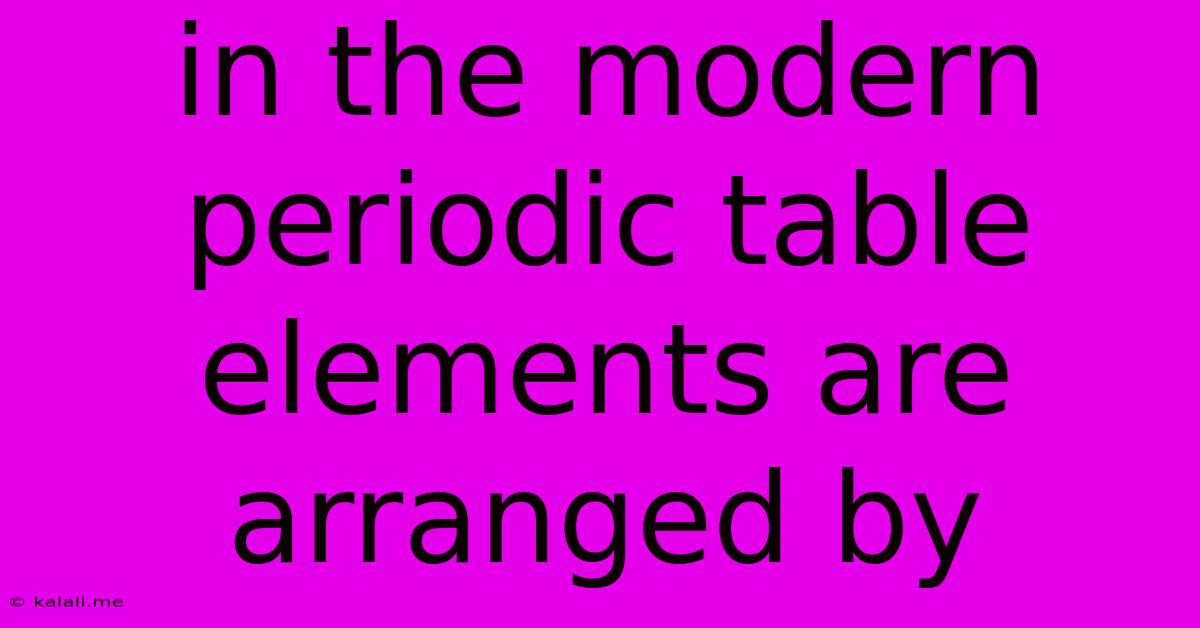In The Modern Periodic Table Elements Are Arranged By
Kalali
Jun 12, 2025 · 3 min read

Table of Contents
In the Modern Periodic Table, Elements Are Arranged By Atomic Number
The modern periodic table, a cornerstone of chemistry, organizes elements not by atomic weight (as in Mendeleev's initial table), but by atomic number. This seemingly simple change revolutionized our understanding of chemical properties and reactivity. This article will delve into the reasons behind this arrangement, exploring the significance of atomic number and its relationship to an element's position and characteristics within the table.
Understanding the arrangement allows for accurate predictions of element properties, facilitates the study of periodic trends, and provides a framework for exploring chemical reactions. This organization is crucial for both students and professionals in the field of chemistry and related sciences.
Atomic Number: The Key to Organization
The atomic number of an element represents the number of protons found in the nucleus of an atom of that element. This number uniquely identifies each element. Hydrogen, with one proton, has an atomic number of 1; helium, with two protons, has an atomic number of 2; and so on. Crucially, the number of protons dictates the element's chemical properties. Elements with the same number of protons are the same element, regardless of the number of neutrons (isotopes).
Why Atomic Number, Not Atomic Weight?
While Mendeleev's initial periodic table used atomic weight as the organizing principle, it had limitations. Isotopes, atoms of the same element with varying numbers of neutrons, complicated the arrangement. Atomic weight, being an average of the isotopes' masses, didn't always reflect the true chemical behavior of an element.
The discovery of the atomic number and its direct correlation with an element's chemical properties provided a more precise and consistent system. Arranging elements by atomic number neatly resolved anomalies and inconsistencies present in the earlier weight-based tables.
The Structure of the Modern Periodic Table: Rows and Columns
The modern periodic table is arranged in a grid with rows (periods) and columns (groups).
- Periods: Elements within a period have the same number of electron shells. As you move across a period, the number of protons and electrons increases, leading to changes in chemical behavior.
- Groups: Elements in the same group share similar chemical properties because they possess the same number of valence electrons (electrons in the outermost shell). These valence electrons are primarily responsible for chemical bonding and reactivity.
Predicting Properties Based on Position
The arrangement by atomic number allows for the prediction of an element's properties based on its position in the table. This includes:
- Metallic character: Generally, metallic character increases down a group and decreases across a period.
- Electronegativity: This property, reflecting an atom's tendency to attract electrons in a chemical bond, generally increases across a period and decreases down a group.
- Ionization energy: The energy required to remove an electron from an atom generally increases across a period and decreases down a group.
- Atomic radius: Atomic radius generally increases down a group and decreases across a period.
Conclusion
The modern periodic table's arrangement by atomic number is a testament to the power of scientific discovery. This organization provides a clear and consistent system for understanding and predicting the properties and behaviors of elements, forming a fundamental framework for the study of chemistry and related fields. The inherent logic and predictive power make it an invaluable tool for scientists, educators, and anyone interested in the fundamental building blocks of matter.
Latest Posts
Latest Posts
-
Ratio And Proportion Questions With Solutions Pdf
Jun 13, 2025
-
Which Of The Following Is An Alga
Jun 13, 2025
-
Which Earthquake Wave Is More Destructive
Jun 13, 2025
-
What Is The Difference Between Observation And An Inference
Jun 13, 2025
-
Panama Canal Joins Which Two Oceans
Jun 13, 2025
Related Post
Thank you for visiting our website which covers about In The Modern Periodic Table Elements Are Arranged By . We hope the information provided has been useful to you. Feel free to contact us if you have any questions or need further assistance. See you next time and don't miss to bookmark.